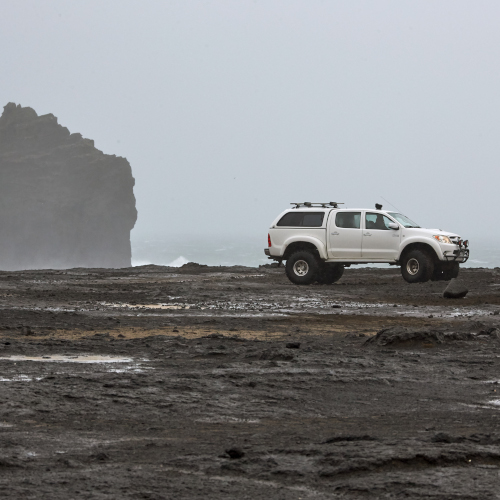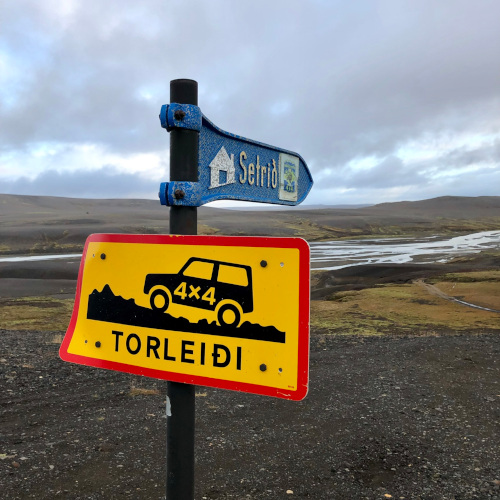If you’ve planned to travel around Iceland by car, we’d like to help you with the preparations, as driving in the land of ice and fire can be quite challenging from time to time, depending on the season and many other things.
General Information About Driving in Iceland

First of all, it’s a great idea to explore Iceland on a road trip, because you’re independent of bus drivers and their schedules. There’s so much to explore on the island that you’ll be happy to be able to travel at your own pace. What’s also great is that you can spend as much time as you like visiting Iceland's sights, when traveling by car.
No matter if you chose a trip along the famous Route 1, Iceland’s Ring Road, including the Golden Circle, or if you chose a trip to North Iceland, for example along the beautiful Arctic Coast Way, we’ve tried to collect the most important information here, to give you some helpful advice.
Let’s start with some websites that you should check out, to be up to date, before you start your road adventure:
• http://www.drive.is/ (general information about driving in Iceland)
• https://safetravel.is/ (website including alerts and warnings)
• https://en.vedur.is/ (to check the weather conditions)
• http://www.road.is/ (for road conditions, as well as closures, etc.)
In Iceland, we highly recommend that you shouldn’t hit the road without a four-wheel vehicle (4x4), especially during the winter months. This is important, as you will often have to drive on e.g. loose gravel roads, or else that will challenge you and your vehicle.
Before we go into detail, here’s the most important rule, concerning driving in Iceland:
NEVER drive off-road! This is not just good advice to protect you from dangerous situations, it’s also strictly prohibited in Iceland! So please do yourself a favour, and stay on the official roads. They will take you anywhere you want to go.
Also: DO NOT stop in the middle of the road, to take photos, especially not in winter, e.g. to watch the Northern Lights. Make sure to pull over, and stay safe.
The general speed limit in Iceland is:
• 50 km/h (ca. 30 m/h) in urban areas
• 80 km/h (ca. 50 m/h) on gravel roads (in rural areas)
• 90 km/h (ca. 55m/h) on paved roads (in rural areas)
Despite the maximum speed limits, keep in mind to slow down on gravel roads, and adapt your driving style to the streets, sometimes the speed limit is not always the right speed. But if you use your common sense, you’ll be all right.
Travel Tips for Driving in the Highlands of Iceland

If you want to visit Iceland’s uninhabited highlands, you will have to drive on so-called F-roads or mountain roads (F stands for Fjallið, which means mountain in Icelandic), which can be difficult to drive on. You are only allowed to drive on those roads with a four-wheel vehicle (4x4) (so the F is a good indicator for that, too ;-) ). Be prepared for big holes, loose gravel, rocks, sheep, or broken roads, due to water or traffic. Some roads might not be recognizable as roads at all but will rather look like mountain tracks. It could happen from time to time that you will slowly have to drive through a river. If you do so, please keep in mind that insurance doesn’t cover damages caused by crossing a river.
Furthermore, you can send your itinerary over to Safe Travel, just to be on the safe side, as the name implies. ;-)
Before you start your trip to the highlands, make sure to check if there are any current road closures, to avoid unnecessary and unpleasant surprises. F-roads are usually open between June and September.
Other Things to Keep in Mind:
• gas stations are often quite far apart, so make sure to fill your tank at the right time, and know your 4-digit PIN for your credit card, since you’ll need it at some gas stations
• make reservations if you want to stay in one of the few places in the highlands overnight
• be careful when crossing rivers etc., especially glacial rivers can change quickly and be dangerous
• the minimum age for car rentals in Iceland is 20 years, depending on the company, and 23 years for minibusses
• when you come across a single-lane bridge in Iceland, slow down, and let the driver from the opposite direction pass first, if he’s closer to the bridge than you are
Driving in Iceland in Winter
As mentioned before, the F-roads to travel the highlands in Iceland are closed during the winter months (October-April/May), because of snow, ice, avalanches, flooding, strong winds, etc.). But it is of course still possible to drive through other parts of the country and enjoy Iceland’s beauty and especially the Northern Lights in winter.
What most people underestimate when they come to Iceland is that the weather conditions can change very quickly. So in case you get in a dangerous or unexpected situation, rather wait where you are, instead of trying to drive as quickly out of the weather as possible, as it might change back to normal all of a sudden, too.
Generally speaking, it’s always a good idea to keep a safe distance from other people when driving on icy roads, as you can never know how they will react in certain situations. Also, don’t underestimate strong winds that could also cause damage to your car, so open doors slowly, when you get out.
And last, but not least: dress warm – it’s all about thermals! ;-)
If there are any questions left, we hope this video, made by locals in Iceland, will answer your remaining questions: Have a great trip to Iceland!
